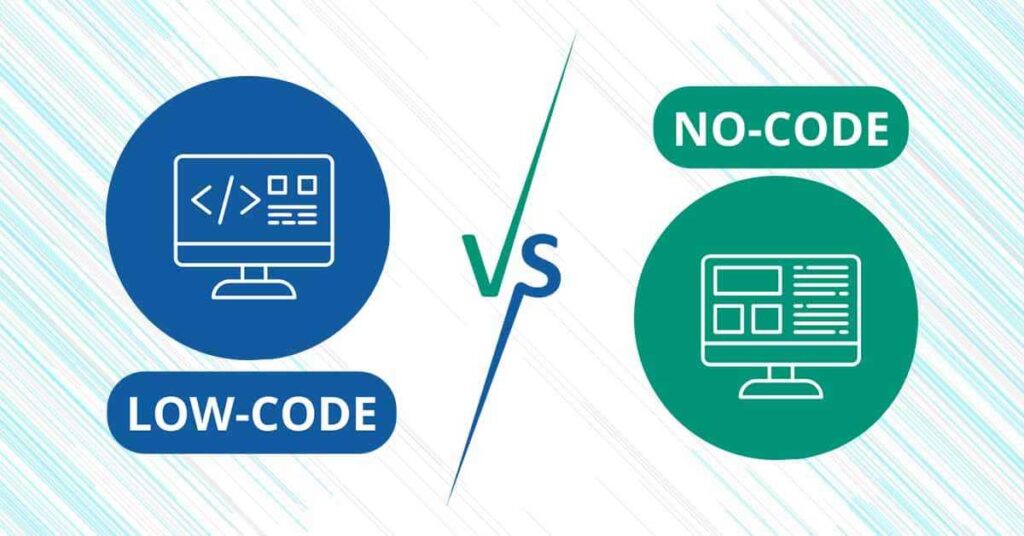Low Code/No Code Development ! In recent years generation landscape within United States has witnessed extensive shift in how software applications are advanced and deployed. At vanguard of this modification is upward push of low code and no code development structures. These progressive processes to software introduction are reshaping way groups marketers & even individuals bring their virtual ideas to lifestyles.
Low Code/No Code Development or improvement consult with strategies of making software packages with minimal or no conventional programming required. Instead those systems make use of visible interfaces drag and drop components & pre constructed templates to enable customers to assemble practical packages without huge coding expertise. This paradigm shift isnt always just fleeting trend however fundamental exchange inside software improvement surroundings particularly within United States in which technological innovation is cornerstone of financial boom.
The significance of low code/no code improvement within US tech panorama cant be overstated. As organizations across numerous sectors try for digital transformation and are trying to find to streamline their operations call for for custom software answers has skyrocketed. However conventional software program improvement methods regularly war to maintain tempo with this demand hindered by means of lengthy improvement cycles excessive fees & scarcity of professional programmers. Low code and no code systems have emerged as compelling strategy to these demanding situations imparting faster extra reachable & fee powerful alternative to traditional software improvement techniques.
In this comprehensive exploration of low code/no code improvement within USA we are able to delve into origins of this movement observe its middle concepts & analyze its effect on various industries. Well also talk advantages and challenges associated with these systems explore their programs in extraordinary sectors & consider destiny trajectory of this transformative approach to software program creation.

The Rise of Low Code/No Code Development Platforms
The idea of simplified software improvement is not completely new. In truth roots of Low Code/No Code Development may be traced again to early days of computing when fourth era programming languages (4GLs) and fast application improvement (RAD) tools first emerged. These early tries at simplifying software introduction laid groundwork for more state of art low code and no code structures we see today.
However actual rise of low code/no code systems inside United States started in earnest for duration of 2010s. This period noticed convergence of several key factors.. that created right environment for these platforms to flourish. proliferation of cloud computing improvements in synthetic intelligence and system gaining knowledge of & developing want for virtual transformation throughout industries all contributed to speedy adoption of low code and no code solutions.
One of number one drivers in back of surge in low code/no code adoption has been chronic shortage of skilled software builders in US task market. As companies more and more depend on custom software program answers to remain competitive call for for builders has long way outpaced supply. This abilties gap has created bottleneck in virtual innovation with many groups struggling to discover talent had to convey their thoughts to fruition.
Low code and no code systems have emerged as compelling strategy to this hassle enabling individuals with limited programming experience to create useful programs. This democratization of software development has allowed businesses to faucet right into broader pool of talent empowering “citizen developers” to make contributions to introduction of digital solutions.
Another significant component driving adoption of low code/no code structures in USA has been want for fast digital transformation. In an increasingly more aggressive commercial enterprise landscape corporations are below stress to innovate quick and adapt to converting marketplace situations. Traditional software development techniques with their prolonged improvement cycles and excessive charges often warfare to preserve pace with these demands. Low code and no code platforms offer faster more agile technique to application development allowing groups to carry new ideas to marketplace greater quickly and iterate on present answers with more ease.

Understanding Low Code/No Code Development
Low code improvement represents middle ground among traditional coding and no code solutions. It is an approach to software improvement.. that requires minimal hand coding rather counting on visible interfaces and pre built components to boost up creation of programs. middle concepts of low code improvement revolve around simplifying development manner whilst nonetheless maintaining diploma of flexibleness and customization.
At its coronary heart low code development is set abstraction. These systems abstract away tons of complexity concerned in conventional software program improvement supplying users with intuitive visible equipment for designing user interfaces defining business common sense & integrating with outside systems. This abstraction allows builders to cognizance on high degree capability and user experience of their packages rather than getting bogged down inside intricacies of coding syntax and infrastructure control.
Another key principle of low code improvement is using pre constructed components and templates. These reusable building blocks allow developers to quickly collect applications by using combining pre current elements rather than coding whole thing from scratch. This method now not handiest accelerates improvement system however also promotes consistency and decreases chance of mistakes.
In america numerous low code platforms have won giant traction across various industries. Platforms like OutSystems Mendix & Microsoft Power Apps have become popular selections for companies looking to boost up their application improvement processes. These platforms provide number of features designed to support company grade utility improvement which include sturdy security features scalability options & integration abilities with current IT systems.
OutSystems as an example has carved out strong presence within US marketplace with aid of imparting complete low code platform.. that supports development of internet and cellular programs. platforms visual improvement surroundings coupled with its capacity to generate excessive overall performance scalable code has made it fave amongst corporations looking to modernize their legacy systems and hastily deliver new virtual reviews.
Mendix some other main participant within US low code market has won recognition for its attention on collaborative development. platforms functions guide teamwork between business customers and expert builders fostering extra inclusive and efficient development procedure. This approach has resonated with many US companies looking for to bridge gap among IT departments and commercial enterprise devices.
Microsofts Power Apps has additionally visible sizable adoption in USA particularly among organizations already invested within Microsoft ecosystem. As part of broader Power Platform Power Apps allows users to create custom enterprise packages.. that combine seamlessly with different Microsoft offerings together with Office 365 and Dynamics 365. This integration capability has made it an attractive choice for agencies looking to extend and personalize their present Microsoft based totally workflows.

Low Code/No Code Development Explained
While low code systems nevertheless require few level of technical skillability no code development takes concept of simplified software advent step further. No code structures are designed to be accessible to customers with little to no programming enjoy permitting proper “citizen developers” to create purposeful packages thru absolutely visible interfaces.
The essential idea in back of no code improvement is whole abstraction of code. Users interact with platform thru graphical consumer interfaces use of drag and drop components visual workflow builders & pre configured templates to assemble their programs. This method removes need for any manual coding making software program development handy to far wider target market.
No code platforms commonly provide various pre built modules and integrations.. that users can combine to create custom packages. These might consist of shape developers database control equipment automation workflows & connectors to popular 0.33 birthday party services. By assembling those components customers can create entirety from easy information series apps to complicated commercial enterprise process automation answers.
In American marketplace several no code answers have gained prominence catering to distinctive wishes and use instances. Bubble for instance has emerged as famous choice for marketers and startups looking to construct net applications without coding. platforms visual development environment permits customers to create complex interactive internet apps entire with databases person authentication & API integrations.
Airtable every other widely adopted no code platform within USA has observed achievement by way of reimagining spreadsheet as bendy utility improvement tool. Users can create custom databases paperwork & workflows use of Airtables intuitive interface making it popular for undertaking control stock monitoring & different facts centric packages.
Zapier whilst no longer complete fledged application improvement platform has turn out to be an critical no code device for many US agencies. It permits users to create automated workflows among specific net packages with none coding permitting powerful integrations and manner automations.. that could traditionally require custom improvement.
These no code systems have democratized software introduction inside United States permitting individuals and small groups to deliver their ideas to life with out want for steeply priced development resources. This accessibility has fostered brand new wave of innovation with citizen builders creating area of interest packages and solutions.. that might not have been economically possible under conventional improvement fashions.

Benefits of Low Code/No Code Development Approaches
The adoption of low code and no code improvement strategies in United States has been driven by way of numerous compelling advantages. These platforms provide advantages.. that deal with among ache points related to conventional software improvement making them an attractive choice for organizations of all sizes.
One of maximum giant advantages of low code/no code improvement is acceleration of improvement cycles. In traditional software improvement projects can take months or maybe years to move from thought to deployment. Low code and no code systems dramatically reduce this time frame permitting programs to be created and launched in count of weeks or even days. This speedy improvement functionality enables corporations to respond greater quickly to market adjustments purchaser wishes & rising possibilities.
The speed of development is performed through several features commonplace to low code/no code structures. Visual development environments cast off need for writing widespread code even as pre constructed components and templates offer head begin on commonplace functionalities. Automated checking out and deployment methods in addition streamline development lifecycle reducing time and effort required to convey packages to marketplace.
Cost effectiveness is every other key gain of low code/no code procedures. Traditional software program improvement can be expensive requiring sizeable investments in professional developers infrastructure & gear. Low code and no code structures reduce these expenses in several ways. By allowing faster development they lessen individual hours required to complete projects. abstraction of complex technical information also means.. that organizations can leverage much less luxurious generalist builders or maybe non technical team of workers to create programs as opposed to relying totally on high fee expert programmers.
Furthermore many low code/no code platforms perform on cloud based infrastructure putting off want for groups to spend money on and hold their very own development and web hosting environments. This shift from capital expenditure to operational expenditure may be in particular beneficial for small and medium sized firms inside USA allowing them to get entry to organization grade development capabilities without related upfront charges.
Perhaps most transformative benefit of low code/no code improvement is democratization of software advent. These systems have opened up utility development to much wider target audience empowering commercial enterprise customers area professionals & different non technical personnel to create answers to their very own troubles. This democratization has numerous effective results on corporations.
Firstly it reduces load on IT departments allowing them to attention on greater complicated venture crucial tasks while empowering other departments to deal with simpler application improvement responsibilities. This can lead to extra green allocation of technical sources within corporations.
Secondly it brings power of software advent in direction of individuals who apprehend enterprise issues excellent. When domain professionals can immediately translate their understanding into functional packages it frequently outcomes in solutions which might be greater intently aligned with real commercial enterprise wishes. This can result in extra effective person pleasant applications and faster iterations primarily based on consumer feedback.
Lastly democratization of development fosters subculture of innovation inside companies. When extra personnel have tools to convey their ideas to lifestyles it can result in proliferation of novel answers and improvements to existing tactics. This backside up innovation can be powerful driving force of digital transformation and competitive gain for US agencies.

Challenges and Limitations
While low code and no code development systems offer severa benefits in addition they come with their very own set of challenges and boundaries. As these methods benefit recognition within United States it is important for groups to be aware about capability pitfalls and constraints.
One of primary concerns surrounding low code/no code systems is security. As those equipment make it easier for non technical customers to create and set up programs there is an improved danger of safety vulnerabilities being introduced inadvertently. Citizen developers may not have equal level of safety awareness as expert builders potentially leading to applications with susceptible authentication insecure records managing or different protection flaws.
To address these concerns many agency grade low code/no code structures have built in security capabilities and great practices. However organizations still need to enforce right governance structures and security protocols to ensure.. that programs created via these structures meet company and regulatory protection standards. This regularly requires collaboration among IT safety groups and citizen developers in addition to ongoing schooling approximately protection satisfactory practices.
Scalability is some other undertaking.. that organizations can also face when adopting low code/no code solutions. While these platforms are first rate for hastily prototyping and deploying applications some may additionally battle to handle load as consumer numbers develop or as packages grow to be extra complicated. This can be especially elaborate for organizations.. that revel in speedy boom or unexpected spikes in consumer hobby.
Some low code structures have made giant strides in addressing scalability concerns presenting features like computerized scaling and performance optimization. However corporations must cautiously compare scalability capabilities of any platform they are considering mainly if they anticipate excessive growth or have project important programs.
Integration complexities also can pose challenges for Low Code/No Code Development. While many systems provide pre built connectors to famous offerings and databases integrating with legacy structures or area of interest programs can nonetheless be difficult. This can restriction usefulness of low code/no code solutions in organizations with complex heterogeneous IT environments.
To triumph over this task few agencies in USA have followed hybrid approach use of low code/no code structures for speedy utility improvement whilst counting on traditional improvement techniques for complex integrations or custom capability. This method lets in them to leverage blessings of both worlds however it calls for cautious making plans and coordination among citizen developers and professional IT groups.
Another hassle of low code/no code structures is ability for supplier lock in. As companies construct greater packages on particular platform they will locate it more and more hard to replace to opportunity answers or revert to standard improvement techniques. This can be specially complicated if designated platform doesnt preserve tempo with technological advancements or if its pricing version changes unfavorably.
To mitigate this risk few organizations within USA are adopting multi platform techniques use of one of kind low code/no code gear for distinctive use instances. Others are specializing in structures.. that offer export abilties or generate standard code supplying extra flexibility for future migrations.
Despite those challenges advantages of Low Code/No Code Development frequently outweigh restrictions for lots agencies. As era keeps to mature and exceptional practices evolve we are able to assume to peer lots of those challenges addressed further cementing function of low code/no code improvement in US technology panorama.